
- Computer Concepts - Home
- Introduction to Computer
- Introduction to GUI based OS
- Elements of Word Processing
- Spread Sheet
- Introduction to Internet, WWW, Browsers
- Communication & Collaboration
- Application of Presentations
- Application of Digital Financial Services
- Computer Concepts Resources
- Computer Concepts - Quick Guide
- Computer Concepts - Useful Resources
- Computer Concepts - Discussion
Computer Concepts - Internet Access Techniques
Internet can be accessed using following methods −
Dial-up Connections
In dial-up connection, computer uses its modem to dial a telephone number given to the user by an Internet Service Provider. This launches a connection between personal computer and ISP server. The process begins when the ISP server answers, and ceases when your computer or the server "hangs up". This is similar to a traditional telephone call. Most ISP servers disconnect automatically after a certain period of inactivity. Once a connection is configured on the users computer, he/she can use the connection. It is secure and de-allocates unused memory automatically.
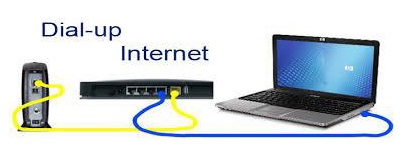
Broadband Connection
Broadband connections are considered as high speed connections, as they use modes that can handle several signals at once, such as fiber optics, twisted pair cables, coaxial cable and other technologies. Even with hundreds of users on the network, these connections allow large files and complex web pages to download quickly. To be considered as a broadband, the connection must be able to transmit data at a rate faster than is possible with the fastest dial-up connection. Downloading and uploading content will be fast.
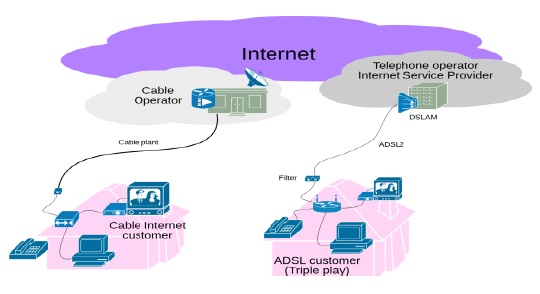
Integrated Services Digital Network (ISDN) Service
Integrated Services Digital Network (ISDN) is a digital service that simultaneously transmits voice & data, and controls signals over a single telephone line. ISDN service operates on a standard telephone line, but requires a special modem and phone service, which adds to the cost. An ISDN data connection can transfer data up to 128,000 bits per second (128 Kbps). It helps to connect a PC, telephone and fax to a single ISDN line and use them simultaneously.
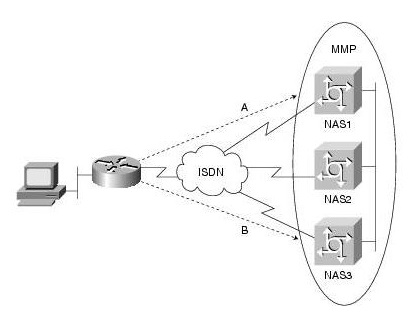
Digital Subscriber Line (DSL)
Digital Subscriber Line is similar to that of ISDN in using telephone network, but it uses more advanced digital signal processing and algorithms to squeeze maximum number of signals through telephone lines. DSL also requires changes in components of telephone network before it can be offered in any area. Like ISDN, DSL provides simultaneous data, voice and fax transmission on the same line. Several versions of DSL services are available for home and business use; each version provides 24/7 full-time connection at different levels of service, speed, bandwidth and distance.
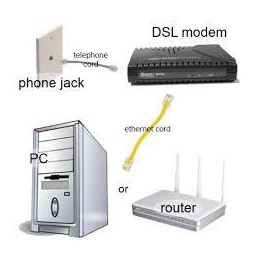
| DSL Type | Maximum Sending speed | Maximum Receiving speed | Maximum Distance | Lines Required | Phone Support |
|---|---|---|---|---|---|
| ADSL | 800 Kbps | 8 Mbps | 5,500 m | 1 | Yes |
| HDSL | 1.54 Kbps | 1.54 Mbps | 3,650 m | 2 | No |
| IDSL | 144 Kbps | 144 Mbps | 10,700 m | 1 | No |
| MSDSL | 2 Mbps | 2 Mbps | 8,800 m | 1 | No |
| RADSL | 1 Mbps | 7 Mbps | 5,500 m | 1 | Yes |
| SDSL | 2.3 Mbps | 2.3 Mbps | 6,700 m | 1 | No |
| VDSL | 16 Mbps | 52 Mbps | 1,200 m | 1 | Yes |
Cable Modem Service
Now-a-days many cable television companies use some percentage of their networks bandwidth to provide internet access through prevailing cable television connections. Since this connection uses a special cable modem, it is called "Cable Modem Service". Cable television systems transmit data via coaxial cable, which can transmit data as much as 100 times faster than common telephone lines. Coaxial cable allows transmission via several channels simultaneously, i.e., the internet data can be transmitted on one channel, while audio, video and control signals are transmitted separately. The user can access internet and watch television concurrently, with two non-interfering data streams.
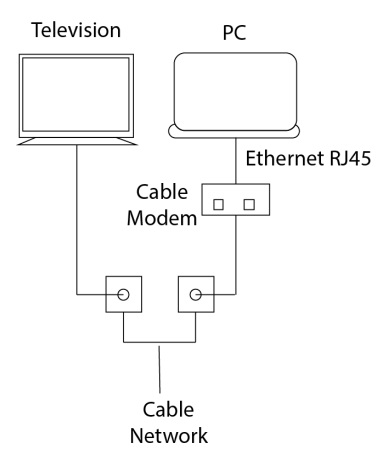
Wireless LAN (WLAN) Connections
Wireless LAN connections are very common these days, which are based on the technology that is often cited as Wi-Fi (Wireless Fidelity). The distance covered by WLAN is usually measured in meters rather than miles. Therefore, this is not a technology that connects directly to an ISP but can be used to connect to another LAN or device through which internet access is achieved.
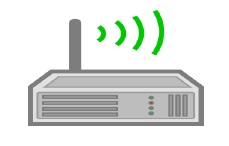
Process
To connect to internet, the wireless access point is connected to a wired LAN like any other devices, and then computers with wireless NICs can access the wired LAN.
"Wireless access point" is a device that acts as a hub or switch.
"NIC" refers to a Network Interface Card which helps to identify a computer on a network.
Wireless WAN (WWAN) Connections
A WWAN is a digital network that spans over a large geographical area. A WWAN accepts and transmits data using radio signals via cellular sites and satellites. At the switching center, the WWAN divides off into segments and then connects to either isolated or public network through telephone or other high speed communication links. The data is then linked to an organizations existing LAN/WAN infrastructure. The coverage area for WWAN is normally measured in miles (kilometers) with a data transmission rate of 100 Mbps.
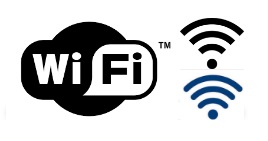
Satellite Services
Satellite services provide a mutual (two-way) communication between user and the internet. This provides a full-time connection which is used in armed forces, business, etc. It includes two parts −
Transceiver − A satellite dish that is placed outdoors in direct line of sight to one of the several satellites in geostationary orbit.
Modem-like device − It is connected to a dish, placed indoors and connected to a LAN or computer.
